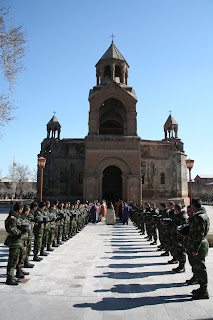Lenten Journey Day 20 – Seeing from Above
Lenten Recipe
Day 20 – Seeing from Above
You’ve made it! You are at the half-way mark of this Lenten journey. Twenty days behind you, twenty days in front of you. You are at the summit, in a sense, looking out from the mountain top and seeing all things below you. You notice the path that you have taken over the last twenty days. Your food intake is restricted but your prayer life is unfastened and more focused than it was before you started. You are being challenged to accept Christianity on Christ’s terms, that is, you are placing the Christ’s teachings of love, of care, of honor and humility into action. And that is only when you look back. Now, take a look forward at the path for the next twenty days. You quickly realize that at the end of that path it merely connects to a longer road: the journey of life.
From this vantage point – looking from above, from the summit – you see your past and your future, and realize that you are standing at the most beautiful and most critical place of all; that is, you are in the present. The one truth that connects you not only with the past and the future, but also allows you to understand this expedition as one step in the bigger journey of life, is the harmony you feel with all things and people around you. This is an expression of being united with God. In fact, God is the eternal present. He is the “I Am.” Not the “I Was” nor the “I Will Be” but the “I Am” and our connection with God is our link to the beginning of time and our roadmap on the course to eternity.
On this third Saturday of the Lenten season, the church directs our attention to a group of men who stand at the summit of all spirituality. Some of the saints remembered by name are St. John of Odzoun, St. John of Vorodon and St. Gregory of Datev. When we remember these Church giants during Lent, we see the example they left of connecting to a higher life. By being elevated to sainthood we understand that they are human, like you and me, with all the frailties, difficulties and challenges that life gives us be they spiritual, emotional or physical. Yet these people rose to the occasion. They followed God’s path and stood at the summit, at the top, looking out at a life that is full and abundant. Looking out at the beauty that God has created all around them and offering their spirits to the world. Ultimately, isn’t that our purpose? We strive to be at harmony with all those around us, to strengthen our relationships with people, with life itself. In that harmony, we can look from the summit, look from above, at a world that is so beautiful that we now offer ourselves, our souls to the collective, to the mix of life.
Today’s message is perhaps the most profound message of all. We are standing at the summit when we are appreciative of all that God has given us. In the act and spirit of thanksgiving we realize that we indeed have a beautiful vantage point of life. We are at the summit and can look all around. We begin sensing with our hearts because our hearts are now sensitive to the wonders all around, to the sounds, to the sights, to the smells, the tastes, the touch of beauty. Today we come to terms with the value of this journey and the road ahead. The path ahead? It is a downhill. We’re going to make it! We’re going to make it not only through the next twenty days, but we’re going to make it through life.
As difficult as life gets, we now have the tools, the confidence, the discipline and we are going to make it. This is one of the most beautiful lessons that come to us from the Lenten season: that God really has given us all the tools necessary to fight the battles and gives us all the strength necessary to overcome our difficulties. Ours is to confide and trust in Him. We are confident to know that this path is a simple one because, it is the path of life.
We conclude with prayer of St. Nerses Shnorhali,
All mericiful Lord, have mercy on all Your faithful, on those who are mine and on those who are strangers. On those whom I know, and on those whom I know not, on the living and on the dead. Forgive all my enemies and those who hate me the trespasses they have committed against me. Turn them from the malice they bear toward me that they may be worthy of your mercy. Have mercy on all your creatures, and on me, a great sinner. Amen. (I Confess with Faith 23/24)



